The tools I Use
The Tools I Use
The tools I use most for carving are palm tools. It is these tools that suit best the way I carve and the small scale of most of my work. The work is held in one protectively-gloved hand, while the carving tool is manipulated with the other hand. The cutting movements result from the work-holding hand and the tool-driving hand working together, controlling the force and direction of each cut. The general working principles remain the same as those pertaining to bench carving, but this method and tools, are particularly suited to working at the portable lap-bench I use.
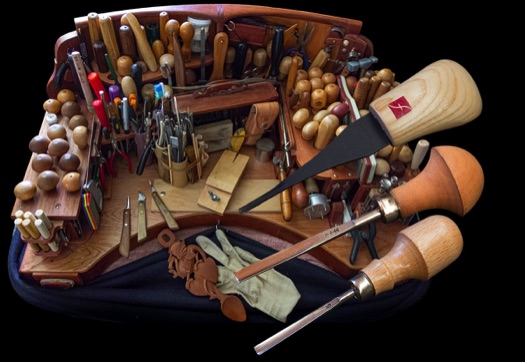
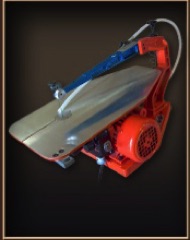
I use a band saw and scroll saw for much of the preliminary work, though I sometimes also use a hand fret saw or piercing saw. Hand tools do most of the rest of the work, particularly the detail work. I have a Dremel but I rarely use it, because it is less convenient to use inside the house, and I prefer the more familiar chisels and knives. Though I do intend to develop some skills using rotary tools and make use of them in my carving... One day in the future.
In addition to palm gouges and chisels I also use knives extensively. Short-bladed straight knives and bent bladed knives with both left and right-handed bent blades. The bent-bladed knives perform the same function, in the same manner as gouges.
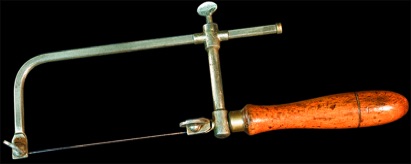
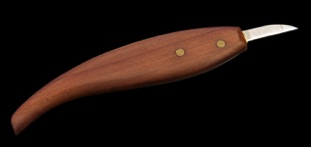
I use a variety of carving tools and while the high quality brands are a pleasure to use and are pretty much ready to use straight off, even the cheapest of the other tools that are available, can be made useful for miniature carving. That is, after some work has been put into improving them. It can take quite a bit of work getting them to a usable state however, but that's why they are cheap! Cheap enough to experiment with however— You can change the geometry of the tool for special uses, and you can do it without jeopardising a more expensive carving tool.
Even cheap bench chisels can be ground to a round-nose cutting-edge and in this form they function well as gouges. Other shapes can also make useful carving tools, when the time is put in to make them razor sharp. It is this sharpness of the edge that enables the tool to do its work. It was the discovering of this at one time, that brought about a massive leap in the interest I had in woodwork and my enjoyment of it. All of a sudden, edge tools sliced pleasantly though timber leaving a glisteningly smooth silky wake instead of chattering across ahead of a swathe of 'gravel-rash'. Ultra-cheap 'carving sets', sets that had convinced me that wood carving was a mysterious dark art, and by nature out of my reach, actually performed pretty well now that razor edges were added.
Before this discovery of sharp tools, but thinking wood carving would be nice to try, I did buy a single Pfiel carving tool. This tool would have been sharp enough to use straight off. However I could only afford one tool, so I chose the most peculiar looking one I could see (deep short bent spoon gouge), my thinking was, that an unusual looking tool must produce unusually good cuts and therefore also produce unusually good work — I couldn't get it to do anything!
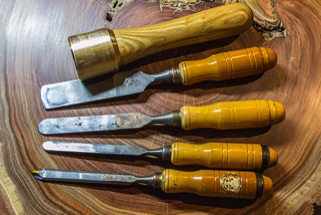
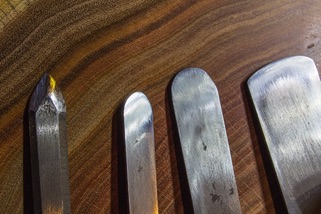
Some of the New Profiles Ground on Cheap Bench Chisels.
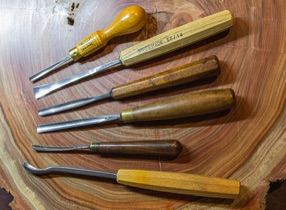
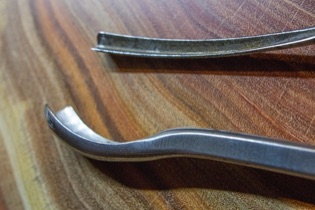
a
a
This particular tool (a) the short bent spoon gouge, together with the other tools shown here, are bench tools and are designed to be used with two hands or with a mallet. When I had carved my first lovespoon, a year or two later, I discovered just what could be done with lovespoons, by reading David Western's Book 'The Fine Art of Carving Lovespoons' , after this I began to take the carving of lovespoons more and more seriously. I could see lovespoon carving as an art form that offers plenty to anyone looking for an expressive and low-cost way of working with wood.
I had been using the longer handled bench tools for carving these early lovespoons, but using them in the manner described before, holding with one hand and carving with the other, rather than using them as bench tools with clamped down work. These tools worked well enough like this but it was obvious that the palm tools would be much more ergonomically suitable.


Knives also play an important role in the type of carving I have been describing, and you could work entirely with knives, however I prefer using gouges and chisels most of the time. Palm tools never-the-less are often used in a manner, and with grips and movements, that relate closely to the way you would use knives.
Bent-bladed knives are particularly useful in spoon carving and, had I found them readily available, I might have used them in preference to gouges. I am used to using gouges and prefer them, but now that I have some bent -bladed knives available, I find them a very useful adjunct to gouges.
One source of a huge supply of all shapes and sizes of bent-bladed and miniature straight bladed knives turned out to be the possibility of re-purposing old steak knives by re-grinding bending and shaping the shortened blades. Not tool steel quality, but still, able to be shaped and bent, without the need of heat treatment and a working knowledge of annealing, hardening and tempering. They could be shaped as is, then sharpened and polished to a useable state before cautiously bending into a bent blade knife that functions surprisingly well. Labour intensive to make, but very cheap, they are worth the effort to make as they can become some unique special purpose tools.
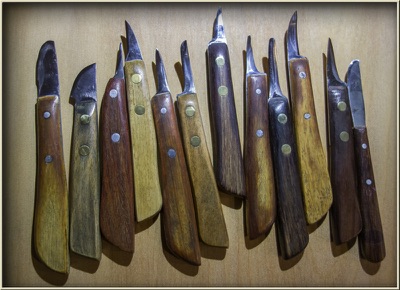
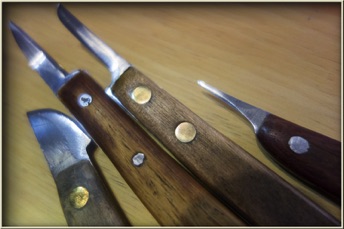
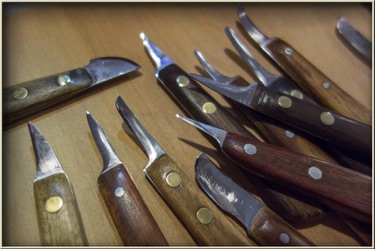
Unique special purpose tools are often necessary in small scale wood art and to my knives and gouges I have added a number of small home-made chisels and other re-purposed tools to accomplish specific tasks. While I was at it, I also produced many experimental tools just waiting for some useful employment, if the opportunity arises. A proportion of these tools are very useful.., others not so much.
Most of these tools are fashioned from music wire with no special treatment apart from hammering, 'grinding' on abrasive papers and some honing and polishing.
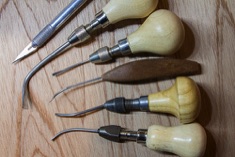
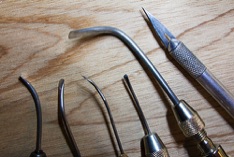
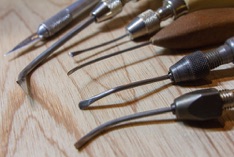
Home-made Tools and Adjustable Graver-handles
Music-wire Chisels and a modified scalpel blade
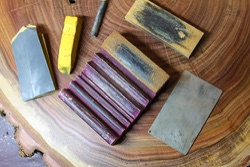
At my lap bench I keep a few aids for keeping tools well honed during use. A diamond grit 'card' and abrasive papers for 'slightly-serious' repair of an edge. Also a Flex-Cut honing board and compound for honing. Fine abrasive papers can also be rolled around various diameter dowels to be used as honing slips on the inside edge of gouges.
A few other tools, which fit the sanding-finishing category are small blades that I use as scrapers. These can be made to cut more aggressively as necessary, by working a fine burr on one edge. A small triangular file can also have the teeth ground off at the end, which is then smoothed and polished on each face to make a pointed three-cornered scraper.
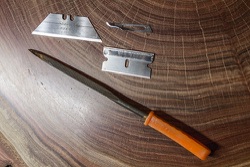
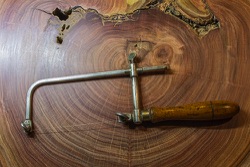
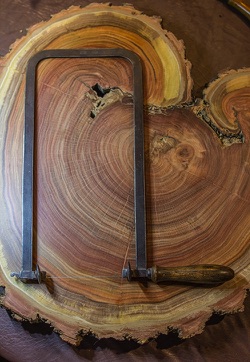
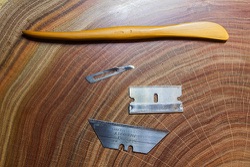
Most of the sawing work I do in the workshop is on the band saw and scroll saw, but I also keep a hand fretsaw and adjustable piercing saw at my lap bench. These are useful for any saw cuts needed and for any very fine fretting that requires a jeweller's piercing saw and blades, I have cut a small bird-mouth recess in the bench peg for this purpose.
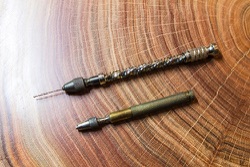
Drill and Pin Vice (to make entry holes for inside fretted cuts and pierced carving)
Piercing Saw and Fret Saw
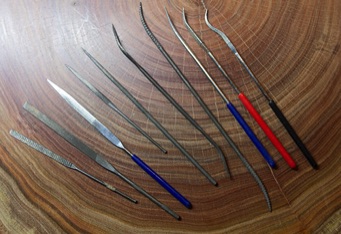
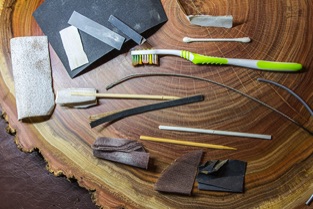
Needle files, Rasps and Rifflers
Sanding Aids
A number of needle files, small rasps and rifflers bridge the gap between shaping/carving and finish sanding
For more information on the tools that I have used for lovespoon carving
Follow this link to The Big Dragon Lovespoon WIP blog posts